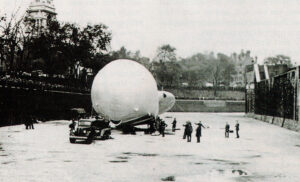
In 1936 the Royal Airship Works at Cardington became a Royal Air Force Station, and training for balloon operators began a year later. The two vast hangars, each 812 ft. long, 272 ft. wide and 186 ft. high, which had formerly housed the rigid airships R100 and R101, were used to store meteorological balloons and barrage balloons. When I was stationed there in 1939 the hangars were also used for a variety of indoor sports – including football!
At the time of the international crisis in September 1938, when Neville Chamberlain returned from Munich to Heston Airport with his ‘piece of paper’, the organisation was sufficiently developed to permit a partial mobilisation of the barrage, and some squadrons were deployed fully-equipped to their ‘war’ sites.
I visited the Tower of London on October 8 1938, and was able to get near enough to the moat to obtain several photographs of the balloon inflation and ascent.
Balloons covering a protected area would force attacking aircraft to fly above them – but how high could the balloon fly? A balloon had to lift not only its own weight of 5501b., but also the weight of the cable. It was finally decided to operate balloons from 7,000ft. to 12,000 ft., preventing accurate aiming and dive-bombing, and at the same time leaving the upper air free for fighter interception.
The usual type of barrage balloon was a streamlined bag of rubber-proofed cotton fabric, with a hydrogen gas capacity of 19,150 cu. ft, an overall length of 63 ft. and a height of 31 ft.
When a balloon was inflated at ground level, the upper compartment was not completely filled, and a false bottom, known as a balloonet, was filled with air through its wind scoop. As the balloon rose, the atmospheric pressure decreased, and the expanding gas pressed the air out of the balloonet. As the balloon descended, the balloonet scooped back air when the gas contracted, thus the shape of the balloon remained constant and three air-inflated stabilisers, like two huge fins and a rudder, enabled it to ride head-to-wind on an even keel.
During the first few months of the war, balloons were flown directly from leading-off gear at the back of their winches, all of which were motor-powered. To moor the balloon on the ground it was necessary to peg out a wire bed and manually haul the balloon down by means of handling guys and rope tackle. With every change of wind, the balloon had to be let up from its bed into its flying position while the bed was re-laid, because it was essential to keep the balloon head-to-wind.
Clearly what was needed was an all-directional bed which would enable a balloon to be turned in all weathers without releasing its moorings or moving the winch. The first experiment was a millstone! It was rolled on to the turf of Hampstead Cricket Club and placed under the surface with a chain reeved through it, leaving a few links above ground to which the cable pulley was attached.
Subsequently, a cradle of rope legs was attached to a central anchorage, loaded with sandbags – later replaced by concrete blocks.
The final improvement was the tail-guy mooring which enabled the balloon to be held with its stabilisers filled with air ready to be raised at a moment’s notice. The balloon was attached at two points only – by the flying rigging and at the stern by the tail-guy. The tail-guy was attached to a wire circle about 180 ft. in diameter, and was moved along the perimeter wire when it was desired to turn the balloon head-to-wind.
The performance of the London barrage balloon units had been so successful that it was decided to proceed with the establishment of barrages in 14 major cities, as well as docks, harbours and river estuaries. With this expansion came the decision to create a separate Balloon Command.
A balloon crew originally comprised two corporals and ten men, to cover shift working. From the summer of 1941 many of the sites were taken over by WAAF crews, after their ten-week course at Cardington. Every week from then on, WAAF members replaced airmen at more and more sites, until they manned the larger proportion of them.
It seemed, sometimes, particularly in sunny weather, that the work of balloon operators was easy compared with other branches of the RAF, but under fire it was one of the most dangerous jobs – and in winter one of the coldest!,
Dennis Strange








